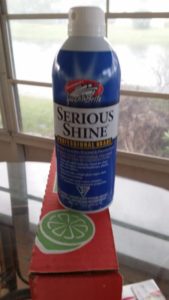


This Serious Shine product has UV inhibitors and anti-static properties so lots of things that cling to your surfaces, don’t .
Check it out at: www.shurhold.com
While this Canadian jaw drops, the locals on the beach barely look up. The small spinner sharks don’t worry anyone here too much.
A surfer ignores the half-hour “no swim order” after it’s spotted and runs back in after a few minutes: “The waves are too good,” he says, flipping his long bangs as he heads into the water off Hutchinson Island.
This 50-kilometre strip of Florida along the Atlantic — from Sebastian down to Stuart — is called the Treasure Coast, for the silver and gold left in the sea after a hurricane wiped out a Spanish fleet in 1715. But that’s not the only bounty here.
Related story: 6 Treasure Coast experience
In the state known for Disney World, spring-break parties and packed beaches, the Treasure Coast offers something else entirely. Long stretches of uncrowded beaches — with ample room in their parking lots — others that are preserved wetlands and plenty of opportunities to hang out with some of the area’s original inhabitants.
Such as alligators.
We see dozens of them lollygagging about during an airboat ride on Blue Cypress Lake, 40 minutes inland from Vero Beach.
“Their ancestors walked with dinosaurs,” our captain says after cracking the requisite joke about going waterskiing in the lake.
“A lot of people don’t realize this is the real Florida,” Capt. John Smith of Florida Airboat Excursions says of the 500-year-old cypress trees and magnificent birds that are soaring overhead — osprey, white egrets and great blue heron.
We’re the only mammals around while horseback riding on the beach on Hutchinson Island, although someone spots a few dolphins frolicking in the ocean. As we amble single file along the water line listening to the waves, soaking up the turquoise of the water and the blue of the sky, we keep our eyes peeled for turtles walking up from the Atlantic to nest on the quiet beach.
Kayaking through the mangroves in Indian River Lagoon — the body of water between Hutchinson Island and the mainland — we watch pelicans dive for fish and meet Larry, a heron minding his own business on a rock.
“He’s retired now,” says Billy Gibson, our Motorized Kayak Adventures guide and avid naturalist. “We know the names of the birds that stay here,” he explains, and grins.
At a visit to the Florida Oceanographic Society’s Coastal Center in Stuart, we hear about local restaurants donating mounds of oyster shells so the centre can build oyster reefs to boost oyster populations and improve the water quality in the area. We learn to keep the beaches “clean, flat and dark” to not upset sea turtles and their babies.
“We get families changing their behaviour on the beaches,” says Zack Jud, director of education and exhibits at the centre. “We teach them that the environment matters.” The big draw is “petting” stingrays in a pool. You hold your hand still and the patient are rewarded with a stingray swimming up against you.
“Ecotourism seems to be the new economic boom for Florida,” says Charles Barrowclough, our guide as we walk along the boardwalk into the Barley Barber Swamp to see a 1,000-year-old bald cypress tree. “People want something to do, something different, and a whole industry has been created around that.”
We pause to taste the salt that’s formed on the leaves of black mangroves and look down to try to spot imaginary faces in the cypress stumps below the boardwalk. “This is old Florida, a remnant of what it was like before the Europeans came here,” says Barrowclough over the choir of cicadas.
“You can ride a roller-coaster anywhere,” he says, looking around at the ancient and very much alive swamp. “You can’t see this anywhere.”
|